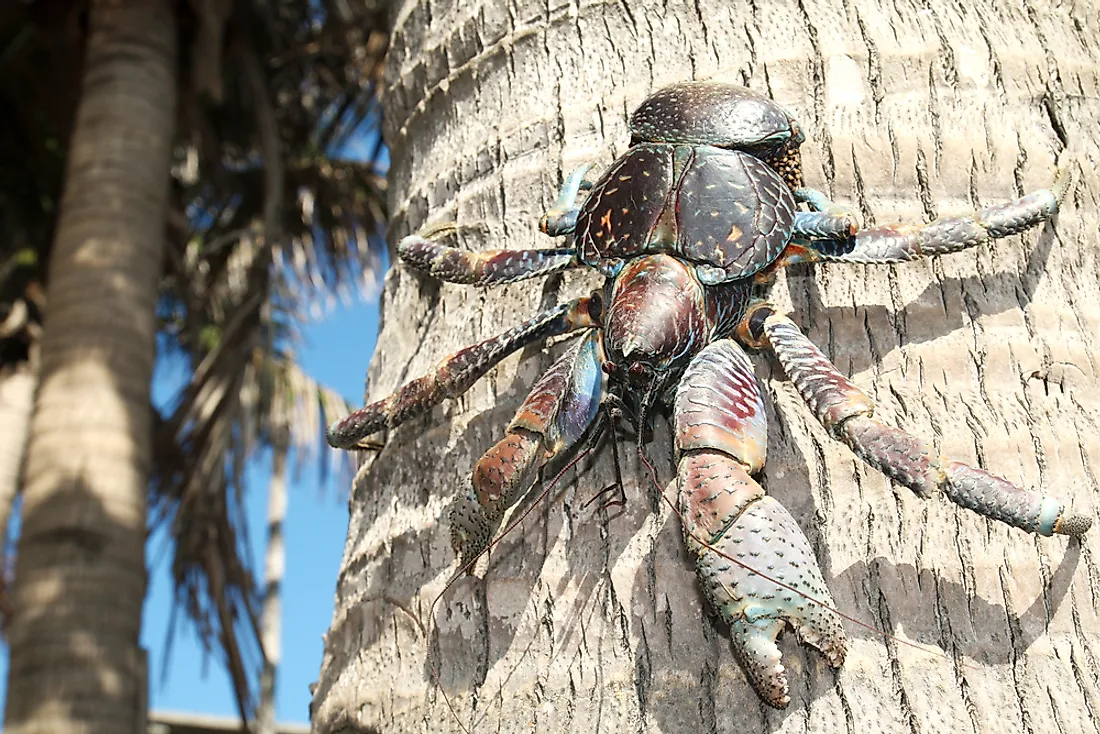Coconut Crabs Facts: Animals of the World

The coconut crab, also known as the robber crab or palm thief, is a type of hermit crab. Although the coconut crab had a wider range, it has become locally extinct in Australia, Mauritius, and Madagascar, and are now found on select islands in the Indian and Pacific Oceans. Unlike other species of crabs, adult coconut crabs cannot swim, and cannot breath under water. The coconut crab gained its name from its association with the coconut palm. It gained its alternate name, the robber crab, due to its tendency to carry off anything found on the ground.
Physical Description
The coconut crab is a large terrestrial arthropod and the world’s largest invertebrate. It has two body parts, a cephalothorax constituting a fused head and thorax, and an abdomen. A carapace, which is a hard shell, covers the cephalothorax. The animal has five pairs of legs, with the front-most pair having large claws. These arthropods are mostly blue, but in some islands, the color may vary from purplish-blue to red-orange. The coconut crab can measure up to 1 meter from one leg to the other, and it can weigh as much as 4.1 kilograms.
Diet
Coconut crabs are omnivores. Their primary diet consists of fruits, seeds, nuts, drupes, and the innermost part of stems (pith) of fallen trees. They also feed on tortoise hatchlings, dead animals, other crabs, and in some cases, they scavenge on the kills of their fellow coconut crabs. While eating coconuts, the arthropods use their pincers to hit the germination pores on the drupe until it breaks. After breaking it they use the claws of their smaller legs to dig out its contents and eat it. They also break coconuts by climbing with them up a tree and dropping them.
Habitat and Range
Coconut crabs are primarily adapted to terrestrial environments. They spend almost all their time on land and only go back to the sea to release eggs. They live in rock crevices and in underground burrows. They dig these holes in loose soil or sand. After digging their nests, they bring the finest fibers of coconut husks inside which they use as bedding. They remain inside their burrows during the day to reduce water loss from their bodies. These animals mostly inhabit the Indian Ocean and central parts of the Pacific Ocean. In the Indian Ocean, Christmas Island boasts the densest and largest coconut crab population, while the Cook Islands have the biggest population in the Pacific.
Behavior
The animals use their excellent sense of smell to locate their food, even from very long distances. Coconut crabs do not swim, except while in the larvae stage. They live alone in their burrows, and they rarely come out during the day. In some densely populated areas, however, some of them hunt during the day to gain a competitive advantage over their counterparts. Coconut crabs use their pincers to grasp prey or predators, including humans. They keep their hold for long periods of time, which causes a lot of pain. The animal is not poisonous, but it may become toxic due to its diet.
Reproduction
Coconut crabs reach sexual maturity when they are approximately five years old. Mating takes place on dry land. The male coconut crab deposits a huge mass of spermatophores on the female’s abdomen. The female lays her eggs, and fertilization occurs as they pass through the mass of spermatophores. After laying the eggs, she glues them on the lower side of her abdomen where she carries them for some months. When the eggs are ready to hatch, the female coconut goes into the ocean to release them, and afterwards she eats the empty egg cases remaining on her body.











